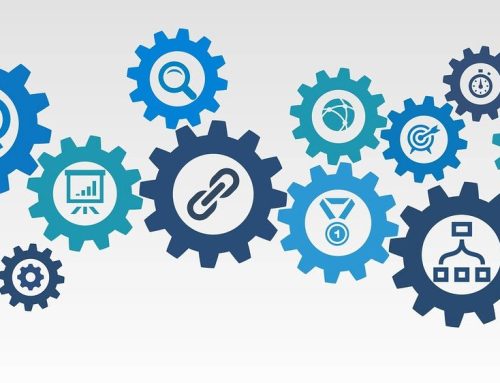Welchen Nutzen Augmented Reality in der Medizin hat.
Es wird erwartet, dass ein Teil des globalen IT-Marktes bis 2020 einen Wert von mehr als 1,5 Milliarden US-Dollar erreichen wird. Augmented Reality (AR) könnte bis 2021 mit einem Hauptanteil von 83 Mrd. Dollar zum Haupttreiber des VR/AR-Marktes werden.
Augmented Reality im Gesundheits- und Bildungswesen hat weitreichende Auswirkungen und kann diese Sektoren dramatisch verändern. Wir haben das Jahr 2018 und haben bisher nur einige, wenige Anwendungsmöglichkeiten in der Praxis gesehen. In diesem Artikel werden wir untersuchen, wie und warum die Augmented-Reality-Technologie bereits eingesetzt wird, um bestehende Bildungs- und Gesundheitsprozesse effektiver zu gestalten.
Was versteht man unter AR?
AR ist eine Technologie, die es ermöglicht, Informationen in Echtzeit über ein mobiles Endgerät in die physische Welt einzufügen. AR-Inhalte können einfach durch Scannen oder Betrachten eines Triggerbildes mit einer mobilen AR-Applikation abgerufen werden. Videos, 3D-Modelle, Spiele oder Animationen können über ihr Smartphone, ihren PC oder tragbare Technik zum Leben erweckt werden.
Wie wird AR im Gesundheitswesen eingesetzt?
Als Multimilliarden-Dollar-Industrie ist das globale Gesundheitswesen ideal, um in Innovationen zu investieren. In den letzten Jahren hat AR die Medizin stark verändert. Einige der großen technologischen Erfindungen haben die Art und Weise, wie Patienten jetzt diagnostiziert und behandelt werden, grundlegend verändert. Zudem konnte durch AR die Ausbildung von Medizinern deutlich verbessert werden. So verwenden viele Studenten bereits AR, um Patienten in 3D zu untersuchen.
Zu den aktuellen Anwendungsgebieten von AR in der Medizin gehören:
- Training und Bildung
- Diagnostische Medizin
- Komplexe und invasive Chirurgie
- Patientenversorgung und Nachsorgeprozess
- Beratung im Gesundheitswesen
Training und Bildung.
Das Unterrichten von Anatomie, chirurgischen Eingriffen etc. ist keine leichte Aufgabe. Jedoch erlauben AR-Applikationen Studenten, den menschlichen Körper zu studieren und Gesundheitsprobleme besser zu visualisieren. AR-Applikationen veranschaulichen, wie der menschliche Körper funktioniert, indem Sie anatomische Details auf einem 3D-gedruckten menschlichen Skelett überlagern. Es ist zwar wichtig, dass Medizinstudenten die Theorie verstehen, aber ihnen muss natürlich auch die berufliche Praxis vermittelt werden. Diese neue AR-Technologie ermöglicht es ihnen, schneller als je zuvor auf Echtzeitdaten und Patienteninformationen zuzugreifen, was den Lernprozess erheblich verbessert und auch eine weitaus zuverlässige Diagnose ermöglicht.
AR-Apps sind auch für die Patientenaufklärung wichtig, insbesondere wenn es um eine effektive Behandlung und Prävention geht. Medizinische und pädagogische AR-Anwendungen können nun einen besseren Einblick in die Auswirkungen bestimmter Krankheiten geben. Durch den Einsatz der AR-Technologie können Patienten und Ärzte gleichermaßen fundiertere Entscheidungen im Gesundheitswesen treffen, die zu einem besseren Standard der medizinischen Versorgung führen.
Diagnostische Medizin.
Eine der herausragendsten Bildungstechnologien im Gesundheitswesen ist Microsofts HoloLens. Dieses Gerät ist nicht nur eine großartige Plattform für das Erlernen der menschlichen Anatomie, sondern kann auch helfen, Patienten effizienter zu diagnostizieren.
Die Echtzeitdaten können die medizinische Diagnostik wesentlich effektiver machen, da Ärzte die genauen visuellen Informationen nutzen. Für das medizinische Personal ist es einfacher geworden, Veränderungen im Gesundheitszustand des Patienten über einen längeren Zeitraum hinweg zu vergleichen und zu dokumentieren.
Komplexe und invasive Operationen.
AR kann die Qualität der Behandlung von Patienten drastisch verbessern. So können beispielsweise Risiken im Zusammenhang mit invasiven Eingriffen reduziert werden, wenn dem Chirurgen die wichtigsten Informationen angezeigt werden. Die invasive Chirurgie benötigt dazu seit jeher Monitore im Operationssaal. Doch heute mit der Entwicklung der AR-Technologie, kann ein Chirurg einfach eine smarte Brille tragen und sich auf die Aufgabe konzentrieren.
Mit den wichtigen Statistiken, die im Auge behalten werden, sind die Chirurgen nicht abgelenkt. Geräte wie HoloLens sind in der Lage, digitale Szenen auf dem, was wir sehen, zu projizieren und Ärzte auf schwierige Eingriffe vorzubereiten. Dies ist für die Qualität der Versorgung der Patienten von großer Bedeutung. AR Medical Apps minimieren das Fehlerrisiko, indem Sie eine vergrößerte 3D-Version der lebenswichtigen Organe überlagern, was das Sichtfeld vergrößert.
Patientenbetreuung und Nachsorge.
Die AR-Technologie ist in der Lage, die Patientenversorgung und die Nachsorgephasen zu verbessern. Sehr oft müssen Patienten nach dem Verlassen eines Krankenhauses mit bestimmten Behandlungen fortfahren. Für manche Menschen kann es ziemlich schwierig sein, den Zeitplan und die Menge der einzunehmenden Medikamente im Auge zu behalten. Während einige Patienten immer noch gewöhnliche Erinnerungsanwendungen bevorzugen, können AR-Anwendungen auch als persönliche Assistenten fungieren und den Patienten daran erinnern, Medikamente einzunehmen oder eine Reihe von Übungen durchzuführen.
Darüber hinaus ist das medizinische Personal in der Lage, Aufzeichnungen zu verwalten und auf Informationen zuzugreifen, um sicherzustellen, dass die Patienten die bestmöglichste Versorgung erhalten. Sie müssen die Daten nicht manuell in das System eingeben. Tragbare Geräte wie Google Glass werden für die Erfassung wichtiger Gesundheitsdaten verwendet. Dies erleichtert das Management und minimiert das Risiko menschlichen Versagens.
Beratung im Gesundheitswesen.
Die Technologie von Google Glass kann auch neuen Müttern beim Stillen helfen. Vor einigen Jahren führte Google Glass zusammen mit der Australian Breastfeeding Association eine Studie durch. Ihre Telefonberaterinnen beobachteten „mit den Augen der Mütter“, während die Mütter zu Hause stillten. Dies half Stillenden, fachkundige Hilfe zu erhalten, ohne dass sie das Baby absetzen mussten.
AR in der Bildung.
AR unterscheidet sich von der VR dadurch, dass es Sie nicht aus der realen Welt herausholt. Eine der fortschrittlichsten Formen der AR-Technologie ist die Verwendung visueller Signale, die Software zum Handeln bringt. Beispielsweise kann eine Bildungsapplikation eine Grafik auf einer bestimmten Seite als Anker verwenden, um Animationen anzuzeigen. Es kann ein 3D-Modell des erkannten Bildes darstellen, das gedreht, gezoomt und detailliert erkundet werden kann. Das Rendern im 3D-Modell von allem, was schwer zu visualisieren ist, kann den Schülern helfen, ein tieferes Verständnis des Themas zu erlangen.
Eine der einfach zu bedienenden AR-Lernanwendungen, die Bilder „lebendig“ zeigt, ist Quiver. Wie bei vielen AR-Anwendungen müssen Sie nach der Installation Triggerbilder von der offiziellen Website herunterladen. Wenn diese Bilder gescannt werden, aktivieren Sie das AR-Erlebnis und ermöglichen es den Schülern, mit 3D-Figuren zu interagieren.
Die wirkungsvollste AR-Technologie beim Lernen ist jedoch interaktiv. Wenn die Schülerinnen und Schüler sich körperlich mit ihren Lernmaterialien beschäftigen, werden sie mental stärker eingebunden und motiviert. Während des interaktiven AR-Prozesses erfasst die Kamera nicht nur das Klassenzimmer, sondern auch die Schüler und ihre Bewegungen.
Die 3 Hauptgründe für den Einsatz von AR in der Bildung:
Interaktive Lektionen
Durch die Integration von Augmented Reality in die Vorlesung können Sie ihre Studenten an den Vorlesungen teilnehmen lassen. Ermöglichen Sie es ihnen, über AR-Anwendungen auf Modelle zuzugreifen und Sie für das Lernen zu begeistern.
Kostengünstige und tragbare Lernmaterialien
Zahlreiche physische Modelle, Tonnen von detaillierten Illustrationen und riesige Kisten mit praktischen Materialien zu bekommen, ist bei weitem nicht einfach eine Belastung. Sie sind nicht leicht tragbar und sehr kostenintensiv, außerdem wird das ganze Zeug früher oder später ausgenutzt. Mit AR besteht erstens keine Notwendigkeit, in physikalische Materialien zu investieren. Zum anderen können die Studierenden zu jeder beliebigen Zeit von ihren eigenen Geräten aus auf die Kursmaterialien zugreifen und mit ihnen interagieren.
Eindrucksvolle Präsentationen
Mit eindrucksvollen AR-Präsentationen kann beim Publikum sehr schnell viel Aufmerksamkeit erzeugt werden. Die Lehrkraft kann Studenten besser einbinden und die Konzepte, die sie in den Vorlesungen lernen, vertiefen.
AR Apps schaffen erstaunliche Lernerfahrungen und unendliche Bildungsmöglichkeiten. In Zukunft wird AR gerade im Stadium der Ausbildung zunehmend zum Einsatz kommen – die Technologie gestaltet die Klassenzimmerumgebung insgesamt interessanter und erleichtern durch Visualisierungen die Vermittlung komplexer Lerninhalte. Es wird viel einfacher, abstrakte und komplizierte Begriffe zu erklären.
Ob Bildung, 3D-Modellierung oder Gesundheitswesen, die Entwicklung von AR-Apps verspricht uns eine ganz neue Welt. AR verändert die Art und Weise, wie Menschen im Alltag mit Dingen und Gegenständen umgehen, radikal und wird in den kommenden Jahren in diesen Bereichen (noch) erhebliche Auswirkungen haben.


